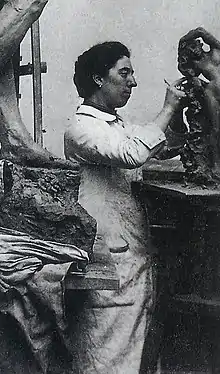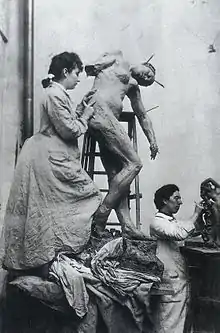Jessie Lipscomb
Jessie Lipscomb, later Jessie Elborne, (13 June 1861 – 12 January 1952) was an English sculptor of the human figure. She worked in Paris in a shared studio workshop in the late 1800s with French sculptor Camille Claudel and two fellow alumni from the Royal College of Art: Amy Singer and Emily Fawcett.
Jessie Lipscomb | |
|---|---|
 Lipscomb in 1887 | |
| Born | 13 June 1861 Grantham, Lincolnshire, England |
| Died | 12 January 1952 (aged 90) |
| Nationality | British |
| Alma mater | Royal College of Art |
| Occupation | sculptor |
| Years active | 1882-1887 |
| Known for | figurative sculpture |
| Awards | Queen's Prize, 1882 National Silver Medal, 1883 |
Early life and education
Jessie Lipscomb was born in Grantham, Lincolnshire, England in 1861, the only child of Sidney Lipscomb, a colliery agent and Harriet Arnold, a barmaid.[1] In 1875, the family moved to Peterborough. She attended the Royal College of Art which was at that time called the National Art Training School in South Kensington.[2] She won two prizes from the school: the Queen's Prize in 1882 and a national silver medal in 1883.[2]
Lipscomb visited Paris with a view to continuing her education. Her instructors, Alphonse Legros and Édouard Lantéri, encouraged Lipscomb to further her studies in Paris where the schooling was more equitable for female students.[1] Two previous graduates of the National Art Training School - Amy Singer and Emily Fawcett - were already living in Paris, and sharing a studio with the young French sculptor Camille Claudel.[3] In January 1884, Claudel's mother Louise wrote to Lipscomb and confirmed the arrangement that she was welcome to lodge with the Claudel family for 200 francs a month.
In 1885, Lipscomb and Claudel were the first women to join Auguste Rodin's all-male atelier to sculpt portions of a major commissioned work: The Burghers of Calais.[1] Lipscomb was a gifted modeler, excelling in sculpting drapery.[1]
Lipscomb and Claudel spent the summer of 1886, from May through September, in Peterborough with Jessie's family.[1] At this time Jessie was exhibiting a terra-cotta bust Day Dreams (1886) in the Royal Academy, and in Nottingham.[2] Letters from Rodin, addressed to Lipscomb, indicate that Rodin was pursuing Claudel during this time, despite the fact that he had a common law wife.[1] After the summer in England, both women returned to Paris and continued to work with Rodin for a time before their paths diverged.[1]
The friendship between Lipscomb and Claudel deteriorated and the latter claimed never to want to see Lipscomb again. However, Lipscomb visited Claudel in 1929,[4] where Claudel was confined in the Montdevergues Asylum.[5] The photograph taken during this visit by Lipscomb's husband[6] is considered to be one of the last known images of Claudel.[7]
Sculpture

From 1885 - 1887 Lipscomb exhibited her artwork annually in exhibitions at both the Royal Academy of Arts and Nottingham Castle Museum.[8] She exhibited a terra-cotta piece entitled Sans Souci, a plaster portrait of Camille Claudel, and a bust of the Italian model Giganti in 1887.
Personal life
Lipscomb married William Elborne[8] on 26 December 1887 and they settled in Manchester. The couple had four children together and died within eight days of each other in 1952.[2]
In popular culture
Maggie Ritchie's 2015 novel Paris Kiss focuses on the relationship between Jessie Lipscomb and Camille Claudel, and offers a highly fictionalized version of Claudel and Rodin's affair.
References
- Ayral-Clause, Odile (2019). Camille Claudel: A Life. Plunkett Lake Press. ISBN 978-0810990760.
- Sara Gray (2019). British Women Artists. A Biographical Dictionary of 1000 Women Artists in the British Decorative Arts. Dark River. ISBN 978-1-911121-63-3.
- Wilson, Susannah (2017). "Gender, Genius, and the Artist's Double Bind: The Letters of Camille Claudel, 1880–1910" (PDF). The Modern Language Review. 112 (2): 362–380. doi:10.5699/modelangrevi.112.2.0362. JSTOR 10.5699/modelangrevi.112.2.0362.
- "Camille Claudel Biography, Life & Quotes". The Art Story. Retrieved 22 April 2020.
- Garman, Emma (12 April 2017). "Genius, Interrupted". Lapham’s Quarterly. Retrieved 22 April 2020.
- Vollmer, U. (2007). Seeing Film and Reading Feminist Theology: A Dialogue. Springer. ISBN 9780230606852.
- Kennedy, Maev (25 March 2017). "Museum rescues sculptor Camille Claudel from decades of obscurity". The Guardian. ISSN 0261-3077. Retrieved 23 April 2020.
- "'Miss Jessie Lipscomb', Mapping the Practice and Profession of Sculpture in Britain and Ireland 1851-1951". University of Glasgow History of Art and HATII, online database. 2011. Retrieved 18 April 2020.
External links
- Some of her sculptures
- A photograph taken by her of Auguste Rodin and his The Gates of Hell